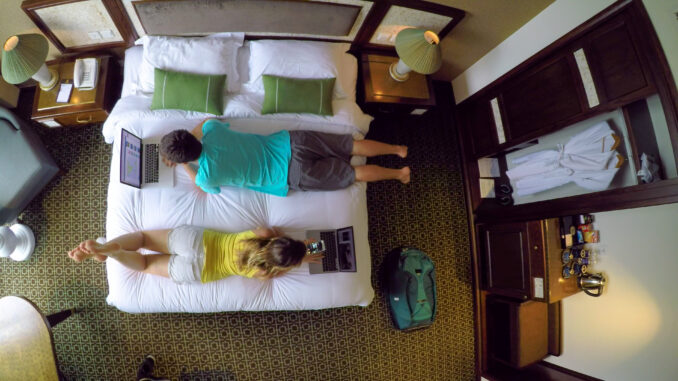
By Adam Edwards, Chief Customer Officer at AppNeta - 11.19.2019
The holiday season is chock-full of traditions that most people anticipate with glee: Feasting with the family, rewatching classic TV specials and hunting down bargains on Black Friday, to name a few.
But there is one ritual that Americans consistently dread this time of year: The waking nightmare that is holiday travel. While not everyone has to travel far to be with the ones they love, more than 54 million Americans trekked 50-plus miles over Thanksgiving in 2018, according to AAA.
For many travelers, the thought of couch surfing on top of battling traffic on the highways and at the airport is a bridge too far. So, naturally, they’ll turn to the hotel brands they trust to give them a reliable “home away from home” when they’re visiting a new zip code over the holidays.
And while guests aren’t looking to live out their Home Alone 2 fantasies with every luxury amenity a kid left unsupervised might request from their lodgings, there are a few prerequisites that travelers have come to expect whenever they’re away from home. In addition to a comfortable bed and a hot shower, fast, reliable WiFi joins the must-have basics hotels have to provide.
The criticality of WiFi
A recent study from Forrester Research found that of all the amenities patrons seek in the hotels they do business with, wireless connectivity is what guests desire most. This makes sense considering how much connectivity influences the lives of every member of the family.
Ninety-four percent of business travelers polled by Forrester, for instance, agreed that well-performing WiFi was “essential to their stay.” While the whole point of holiday travel is to unplug from work, it’s rare for individuals who are accustomed to checking work email on any number of the devices they have handy (smartphone, smartwatch, tablet, etc.) to completely check out. Even workaholics traveling sans family need access to WiFi to download binge-worthy content or update their podcast cache before their next flight when they are getting some downtime from their work commitments.
It’s a critical consideration for kids, too. If a cranky toddler isn’t able to access their favorite Netflix show on a tablet once they’ve settled in from a long car ride, for instance, it’s going to be anything but a joyful holiday for mom or dad.
Perhaps even more importantly, many people’s holidays don’t involve visiting family, but enjoying a relaxing getaway, often abroad. Where international guests are concerned, many may be averse to changing their wireless data plans to accommodate a short trip to a foreign locale.
And with 89 percent of guests “deciding where to lodge based on free reliable WiFi,” according to the 2018 Lodging Technology Study, access to connectivity is now literally the first thing brands should be delivering to guests.
Business consequences of bad connectivity
Poor guest WiFi can result in negative guest satisfaction as measured by post-stay surveys, which hold a lot of weight in a market where 64 percent of leisure travelers claim they aren’t loyal to a particular marquee, according to the 2018 Lodging Tech study cited above. This isn’t just a bad reflection on the brand, as it can result in adverse business consequences for individual property managers, too, including loss of repeat customer business, poor online reviews, managers not getting bonuses, or worse, loss of franchise.
But this also goes beyond just delivering performant guest WiFi, as connectivity is now at the heart of almost every interaction guests have with their hotel brands. For instance, just as shoppers now expect a more streamlined point-of-sale experience when they visit brick-and-mortar storefronts, hotel guests have little patience for bottlenecks at the front desk. If connectivity works and travelers can successfully use an app to check in/out or access their room, they may not ever even need to visit the front desk in the first place.
As a result, the back-of-house applications hotels used to manage their bookings are now often equipped to function on mobile devices, while some brands have removed humans from the equation altogether, instead relying on connected self-serve kiosks to help guests kick-off their stay.
Digital transformation in the hospitality industry
With connectivity playing such a critical business role, hotel brands are exploring similar “digital transformation” initiatives that have already taken root in other sectors by retiring their data-center-centric network architectures for cloud or direct-to-internet configurations, or a combination of architectures supported by SD-WAN.
The benefits here are clear to see. For starters, global hotel brands will need to leverage an array of cloud vendors and ISPs to support and deliver traffic across the network; if IT can retire their physical legacy network infrastructure, they’ll no longer need to exhaust resources to support hardware, nor will they need a local IT presence at each branch location.
Some of the drawbacks, however, might include a lack of visibility into what’s going on locally at each remote location. While the old network architecture that was based around a data center and VPNs allowed IT to have insight into the network elements under their direct control like switches, routers, access points, and firewalls, IT teams lose that visibility when they rely on cloud and Internet exclusively. If one branch location is experiencing poor latency compared to other locations, IT will need a monitoring solution that delivers visibility along each network path to pinpoint the actual cause of the issue and to resolve it.
This is true for assuring that WiFi is getting delivered with minimal delay at each of the brand’s branch locations, too. Rather than supporting a local IT team at each hotel in a brand’s portfolio, a comprehensive network performance monitoring solution should be able to see past local firewalls and into the LAN, giving a centralized IT operation a “local perspective” to identify potential issues isolated to one location on the network.
Travelers are already juggling a lot of considerations as they embark on their holiday travel plans. They shouldn’t have to worry about staying connected to their lives back at home, too, as this is meant to be the most wonderful time of the year. When brands can satisfy their guests with, at the very least, stellar connectivity, a stay with that hotelier could become an annual part of the holidays for years to come.
 Adam Edwards is Chief Customer Officer at AppNeta, the only network performance monitoring solution that analyzes network data through a 4-Dimensional lens, delivering actionable, end-to-end insights from the end-user perspective. With AppNeta’s SaaS-based solution, IT and Network Ops teams at large, distributed enterprises can quickly pinpoint issues that affect network and business-critical cloud application performance, regardless of where they occur. AppNeta is trusted by some of the biggest Fortune 1000 companies, including 3 out of the 5 largest corporations in the world, as well as 4 out of the 5 largest cloud providers.
Adam Edwards is Chief Customer Officer at AppNeta, the only network performance monitoring solution that analyzes network data through a 4-Dimensional lens, delivering actionable, end-to-end insights from the end-user perspective. With AppNeta’s SaaS-based solution, IT and Network Ops teams at large, distributed enterprises can quickly pinpoint issues that affect network and business-critical cloud application performance, regardless of where they occur. AppNeta is trusted by some of the biggest Fortune 1000 companies, including 3 out of the 5 largest corporations in the world, as well as 4 out of the 5 largest cloud providers.
Are you an industry thought leader with a point of view on hotel technology that you would like to share with our readers? If so, we invite you to review our editorial guidelines and submit your article for publishing consideration.


